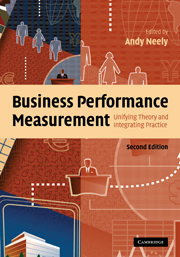Book contents
- Frontmatter
- Contents
- List of figures
- List of tables
- List of boxes
- List of contributors
- Introduction
- Part I Performance measurement – functional analyses and theoretical foundations
- Part II Performance measurement – frameworks and methodologies
- Part III Performance measurement – practicalities and challenges
- Part IV Performance measurement in public services
- Part V Performance measurement – emerging issues and enduring questions
- 20 Does pay for performance really motivate employees?
- 21 Anomalies of measurement: when it works, but should not
- 22 Loosely coupled performance measurement systems
- Index
- References
21 - Anomalies of measurement: when it works, but should not
Published online by Cambridge University Press: 22 September 2009
- Frontmatter
- Contents
- List of figures
- List of tables
- List of boxes
- List of contributors
- Introduction
- Part I Performance measurement – functional analyses and theoretical foundations
- Part II Performance measurement – frameworks and methodologies
- Part III Performance measurement – practicalities and challenges
- Part IV Performance measurement in public services
- Part V Performance measurement – emerging issues and enduring questions
- 20 Does pay for performance really motivate employees?
- 21 Anomalies of measurement: when it works, but should not
- 22 Loosely coupled performance measurement systems
- Index
- References
Summary
Introduction
One ostensible objective of research on performance measurement is to determine the characteristics of measurement systems that lead to high performance. To this end, descriptive theories of performance measurement hypothesize relationships between work contexts, the design of measurement systems, the aptitudes and behaviour of workers, and the outcomes that result from the work. Normative theories specify principles of design for measurement systems intended to produce desirable outcomes.
Usually, normative theories do not specifically assert that high performance results only from performance measurement systems constructed in accord with theory. Nonetheless, high performance achieved via means other than performance measurement should surely operate in a way that is consistent with the mechanisms inherent in these performance measurement theories. Furthermore, some theories in use, such as the one summarized by the widely accepted aphorism “What you can't measure, you can't manage”, seem to imply that a performance measurement system designed according to certain basic principles is a prerequisite for high performance.
This chapter is simple in its layout and objectives. First, we identify a minimal set of principles for designing performance measurement systems that can be extracted from theories in a wide variety of academic disciplines and applied settings. We arrive at three principles that we believe will seem unobjectionable to most performance measurement proponents. Second, we present four vignettes that describe actual events from the airline industry in which the principles of performance measurement seem to be deliberately subverted in order to produce high performance.
Information
- Type
- Chapter
- Information
- Business Performance MeasurementUnifying Theory and Integrating Practice, pp. 449 - 476Publisher: Cambridge University PressPrint publication year: 2007
References
Accessibility standard: Unknown
Why this information is here
This section outlines the accessibility features of this content - including support for screen readers, full keyboard navigation and high-contrast display options. This may not be relevant for you.Accessibility Information
- 2
- Cited by
